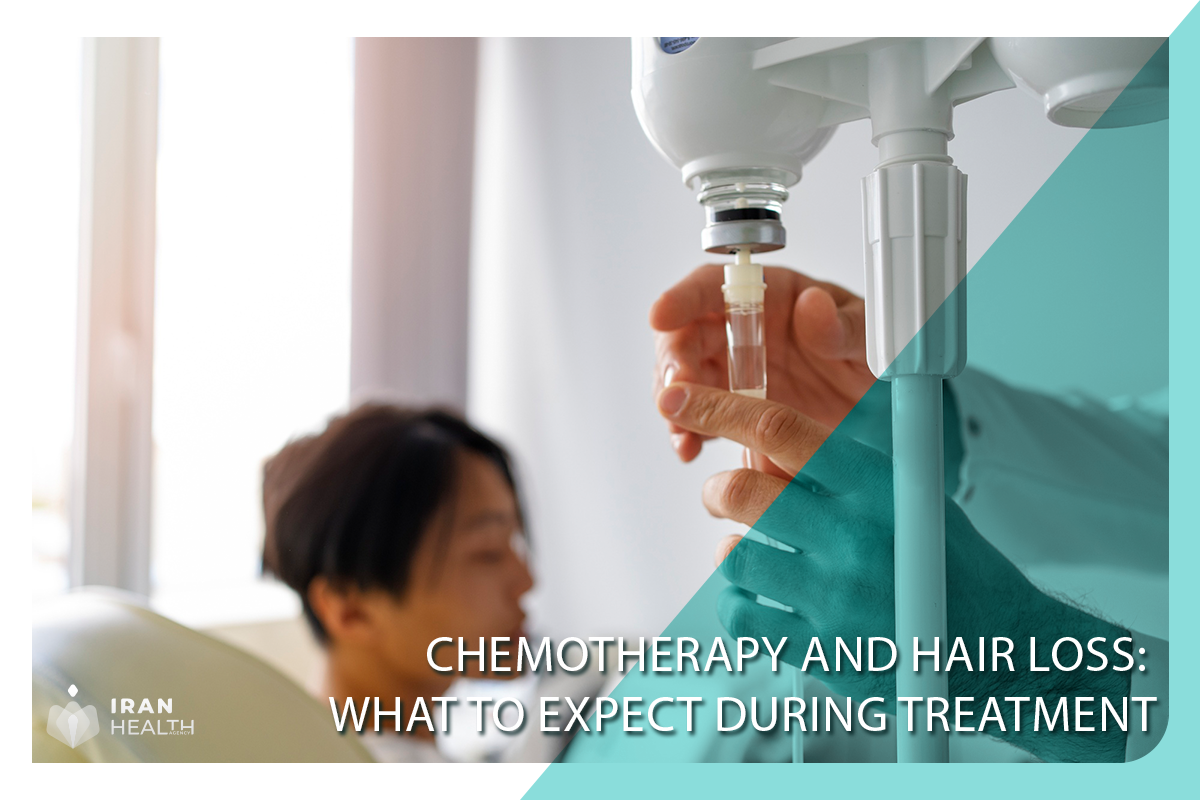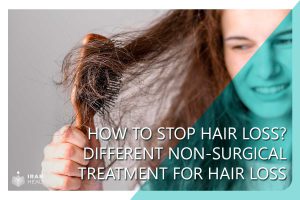This is for informational purposes only. This information does not constitute medical advice or diagnosis
Chemotherapy is a type of cancer treatment that kills cancer cells or stops them from growing. It’s effective against some types of cancer, but it can cause side effects that affect the patient’s quality of life.
Dealing with hair loss due to chemotherapy can be tough. If you’re about to start treatment, it’s important to know what to expect. Your hair might start falling out within a few weeks of your first treatment. It’s not just the hair on your head that might be affected. you might also lose your eyelashes, eyebrows, and even hair on other parts of your body. It’s also common for your scalp to feel tender and itchy.
Don’t worry, though – your hair will grow back once your treatment is over. In the meantime, you might want to think about getting a wig or a scarf to cover your head.
Causes of hair loss during chemotherapy
Chemotherapy drugs can cause hair loss because they affect the cells responsible for producing hair. These drugs target fast-growing cells in the body, including cancer cells, but they can also harm other normal cells that increase, such as hair cells. Damaged hair cells stop producing hair, and the hair that is already there falls out.
The extent of hair loss depends on several factors, including;
- the type and dose of chemotherapy drugs administered, the duration and frequency of treatment
- the individual response of the patient
- the characteristics of the hair.
- Some chemotherapy drugs are more likely to cause hair loss than others, and hair loss may vary from mild thinning to complete hair loss.
Chemotherapy treatment can cause hair loss within two to four weeks after starting. Hair loss occurs on the scalp but can also spread to other body parts, including the eyebrows, eyelashes, and pubic area. After the treatment, hair regrowth may begin within three to six months, although it may look and feel different in texture, color, and thickness compared to before the treatment.
There are ways to prevent hair loss during chemotherapy, like wearing ice caps or scalp cooling systems. They reduce blood flow in your head and prevent hair follicles from being exposed to chemotherapy drugs. But, these methods may only work for some. So, it’s better to consult your healthcare provider before trying them.
What to expect during treatment
As we mentioned before, Hair loss usually begins two to four weeks after the start of chemotherapy, and it may continue throughout the treatment and up to a few weeks afterward.
The hair loss may be gradual or sudden, and it may affect different parts of the body at other times. The scalp may feel tender or sensitive, and the hair may change in texture or color before falling out. Hair loss can be an evident and distressing sign of cancer treatment, and it can affect the way patients feel about themselves and how others perceive them.
Timeline for hair loss during chemotherapy
| Stage | Time | Description |
| Before treatment | – | Before starting chemotherapy, patients can talk to their doctor or nurse about the possibility of hair loss. They can also explore hair replacement options like hats, scarves, turbans, or wigs. They can visit a wig specialist or a hairdresser to find a suitable wig style, color, and fit. To have more control over the hair loss process, they can choose to cut their hair short or shave it off before it falls out. |
| Early treatmein | 1-3 weeks. | When undergoing chemotherapy, hair loss is a common side effect. It usually begins within two to four weeks and can continue throughout the treatment, lasting for a few weeks afterward as well. Hair loss may occur gradually or suddenly, and it can affect different parts of the body at different times. The scalp may feel tender or sensitive, and there may be changes in the texture or color of hair before it falls out. |
| Mid treatment | 1-2 months | Hair loss is a common side effect of chemotherapy. It usually starts a few months after starting treatment and patients may notice loose hair on their pillow, hairbrush or comb, sink or shower drain. Losing hair can be distressing and affect how patients feel about themselves and how others perceive them. It can make patients feel embarrassed, sad, angry, or anxious. They may also feel like they’ve lost part of their identitreatmentman or a woman. |
| Late treatment | 2-3 months. | At this stage, some individuals may experience hair loss, which can extend to their eyelashes, eyebrows, arm and leg hair, underarms, and pubic hair. Patients can wear a wig, hat, scarf, or turban to cover their heads and keep them warm and protected. They can also try different styles, colors, and accessories to convey their personality and mood. Additionally, they can use makeup, jewelry, or glasses to highlight their facial features and divert attention from their hair loss. |
| After treatment | 3-6 months | Of chemotherapy, hair loss typically stops within a few weeks, and new hair usually starts growing back in three to six months. The new hair may look slightly different in texture, color, or curliness compared to the previous hair. To care for their hair and scalp, patients should use mild products, avoid harsh chemicals and heat styling, and protect their scalp from sun, cold, and wind. |
Managing hair loss during chemotherapy
There is no definitive way to prevent or minimize hair loss during chemotherapy, but there are some steps that patients can take to cope with it and reduce its impact. Some of these steps are:
- When your hair starts thinning from chemotherapy, it becomes extra fragile, and important to treat it gently. Consider switching hair care products to more natural, hydrating formulas without harsh chemicals.
- Massage shampoos and conditioners infused with soothing ingredients like jojoba oil or vitamin E onto your scalp.
- Use a wide-tooth comb or soft brush made for fine hair to prevent snapping strands.
- As the hair loss progresses, cover any developing bald patches creatively. Many brands make lightweight caps or turbans covered in soft fabric for sleeping or daywear inside the house when you need a break from wigs.
- Scatter some fun headscarves, hats, or hairpieces throughout the house so you always have options within reach on difficult days.
- Protecting the sensitive scalp is crucial, too when you lose your hair. The skin quickly burns without hair follicles as a buffer, so apply nutrient-rich moisturizers. Seek products with SPF protection if outdoors.
- stay cozy indoors when possible, covering up with soft knit hats. The scalp nerves can overreact to temperature changes. Finally, avoid harsh hair chemicals like dyes or bleach while regrowing your hair after chemotherapy finishes. Treat those fragile strands gently.
Losing your hair can feel devastating, but having an arsenal of comforting hair products and accessories makes a difference. Experiment until you discover what believably replicates your natural hair. The priority is keeping your scalp moisturized and healthy throughout this process. Nurture your body and your strands will bloom back in time.
Emotional support during hair loss
Losing hair can be a challenging and emotional experience for people, and they might need extra help and advice to deal with it. There are different ways to get emotional support to cope with hair loss, such as:
- Coping strategies:
When someone loses their hair, it can be a tough time. But there are ways to cope with the negative feelings that come with it, like chilling out, meditating, saying nice things to yourself, writing down your thoughts, or doing things you enjoy. It’s also important to focus on the good stuff, like how well your treatment is working, the hope of getting better, and the love and support of those close to you.
- Support groups and counseling:
People with hair loss can connect with others going through the same thing by joining online communities or support groups. They can talk to a professional therapist or counselor if they’re feeling down, anxious, or overwhelmed. It’s also a good idea to discuss any questions or concerns about their treatment and its side effects with their doctor or nurse.
As a final note on hair loss:
Chemotherapy is a powerful treatment that can save lives, but one of the side effects is hair loss, which can be super rigid and stressful for patients. Losing hair can make people feel down and change how they think about themselves and interact with others. But, it’s usually not permanent, and there are ways to handle and deal with it during and after treatment. Patients can talk to their healthcare team and their loved ones or seek help from support groups, counselors, or online resources. Losing hair doesn’t mean you’re weak or a failure, it means you’re strong and brave. If you’re going through chemotherapy and losing your hair, know that you’re not alone and still beautiful, confident, and full of hope.
FAQ about Hair loss
How can I stop my hair from falling out during chemo?
Unfortunately, there is no guaranteed way to prevent hair loss during most types of chemotherapy. The drugs target rapidly dividing cancer cells but also affect other quickly growing cells like hair follicles. Cooling caps can possibly reduce the amount of hair loss for some, but be prepared for thinning and shedding locks. Focus extra care on nourishing the scalp to be ready for regrowth.
Why do some chemo patients not lose their hair?
Certain specialized chemotherapy drugs like bleomycin or ABVD regimen for Hodgkin’s lymphoma carry lower risks of causing alopecia or hair shedding. The method of administering chemo through an isolated limb also lessens the likelihood of hair loss occurring. The degree of hair loss varies greatly, depending partly on the chemotherapy mode and dose uniqueness of each person. Genetics plays a role as well.
Should I cut my hair during chemo?”
Some opt to wear hair short preemptively before chemotherapy since hair often begins falling out within 1-2 weeks after starting. Cutting long locks ahead helps lessen the trauma of watching substantial length shed rapidly. But it’s a personal choice – maintaining normalcy by keeping the usual style can help confidence too. Cover with scarves later.
Which chemo does not cause hair loss?
Unfortunately, most common chemo agents like cyclophosphamide and doxorubicin frequently cause pronounced hair thinning within weeks. As discussed previously, certain regimens like ABVD for Hodgkin lymphoma demonstrate lower occurrence of hair loss statistically. Also localized infusion through the limb limits hair falling out. Discuss odds specific to your planned chemotherapy protocol.








